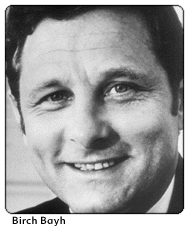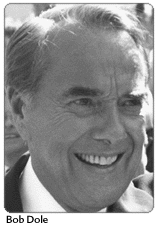n order to understand why the aloof ivory tower of academia is bending
toward the unruly marketplace--that is, why universities have added technology transfer and
economic development to the better established missions of education and research- -it's
necessary to look back 18 years to a law known as the Bayh-Dole Act. But to put the
Act in proper perspective, we must look back a bit further--to the birth myths of the
university.
One account says two universities were founded simultaneously, on contrasting principles.
One group of medieval monks, isolated from the plague-ridden rest of society in their high
stone tower, possibly in Salamanca, Spain, decided they could support their scholarly works
by imparting what they knew to healthy (and, need we say, wealthy) students. However,
another account suggests that universities also have a parallel tradition of serving the society
in which they are embedded more directly. This story holds that a group of ambitious
merchants, possibly in Cambridge, England, believing that education would help them in their
worldly pursuits, set out to hire some expert tutors. These two models--one based on research,
with teaching as a way to pay for it,  and the other based on learning, apparently for its
utility--persisted almost unchanged and usually separate until midway through the 20th
century. In this light, technology transfer is part of a long tradition of response to changes in
society's needs.
and the other based on learning, apparently for its
utility--persisted almost unchanged and usually separate until midway through the 20th
century. In this light, technology transfer is part of a long tradition of response to changes in
society's needs.
Even the industrial revolution had little immediate effect on the university's divided identity.
Formal academic technology transfer really began with the spread of scientific agricultural
practices through the land-grant university system. With the notable exception of the Massachusetts Institute of Technology, guided by
industrialist Vannevar
Bush, most of academia resisted the messy charms of real-world problems. However,
when World War II arrived, the governments of Germany, England, Canada, and the United
States turned to their universities for the technologies to win the war. Famously, MIT's
Radiation Laboratory contributed to anti-aircraft gun control, radar, and electronics, while
Columbia physicists such as I.I. Rabi, George Pegram, Enrico Fermi, and John Dunning served
the war effort through the Manhattan Project. So
when Bush prepared his famous plan for the future of research in the United States, Science:
The Endless Frontier (Washington: U.S. Government Printing Office, 1945), it was
only after academicians had descended patriotically from the ivory tower to dirty their hands
in designing the new weapons of war--and had succeeded, spectacularly.
What followed, of course, were 30-plus glorious years of steadily rising, indeed seemingly
endlessly expanding federal funding for research back in the ivory tower, in an isolation
welcomed by both society and the academy. (Of course, the purity was partial, at best.
Military funding of university research soared. However, contemporary fears that federal
funding would lead to federal control have an interesting parallel today in fears that industrial
funding leads to industrial control.)
expanding federal funding for research back in the ivory tower, in an isolation
welcomed by both society and the academy. (Of course, the purity was partial, at best.
Military funding of university research soared. However, contemporary fears that federal
funding would lead to federal control have an interesting parallel today in fears that industrial
funding leads to industrial control.)
This decision to add research to the traditional academic mission of education was the first
academic revolution, so designated by Christopher Jencks and David Riesman in The Academic Revolution (Garden City, N.Y.: Doubleday, 1968).
The second academic revolution (the title of a forthcoming book by Henry Etzkowitz, SUNY
Purchase), codified by Bayh-Dole and still in progress, was initiated as part of the
controversial attempt to forge a national industrial policy in response to the innovations and
manufacturing competition from Germany and Japan.
Could society do anything to save U.S. industry, after the cutbacks by the great central
corporate research labs? Internal funding of corporate research fluctuates not in accordance
with the need for new products 10 or more years out, but with sales, or worse, in accordance
with the value Wall Street places on cost-saving vs. investment at any given moment. Partly
as a result of the cutbacks and the short- term focus, and partly as a result of the increasing
technology intensity of all industries, even in the very best cases -- IBM, Merck, Du Pont, Bell
Labs, GE, 3M--companies discovered that they could not invent
everything they needed themselves.
According to Jim Turner, long-time staffer at
the House Science Committee, such large
companies were the main focus of attention in 1979 and 1980. They complained that federal
bureaucracy made it difficult to develop civilian or commercial applications of inventions
made under federal (usually military) contracts. But Howard Bremer of the Wisconsin Alumni Research Foundation, the late
Roger Ditzel of the University of
California, and several others saw an opportunity to extend the law to universities and
other non-profits and small businesses also conducting research with federal funding. The Commerce Department's Norman Latker helped mightily
by publishing a study revealing that of 30,000 federally owned patents, almost none had been
commercialized.
President
Carter signed the Bayh-Dole Act (Public Law 96-517) in December 1980. Its main
function was to standardize previously disjointed federal policy. It reaffirmed that ownership
and control of patents derived from federally funded research belonged to the performing
institution, not to the sponsoring federal agency. Bayh-Dole took the decision about
commercialization out of federal hands, insulating the process from political interference, and
incidentally helped start the shrinking of federal government. With later amendments, it
allowed non-profits to offer exclusive licenses, which provided the incentive for the venture
capital industry to invest in unproven university technology, and it required the institutions
to share proceeds with the inventors. Clarification of title helped give companies the
confidence to make investments in unproven technologies.
The results have been dramatic. A trickle of university patents, 200 in 1980, has turned into a
flood -- now more than 3,000 applications a year. Universities' share of the total U.S. patents
issued rose from a fraction of a percent to 3 percent, and much more in certain classes of
advanced technology. In 1980 only a handful of major universities had the resources to fight
the bureaucracy for months or years to get each invention waiver. Now more than 250 belong
to the professional society, the Association of
University Technology Managers (AUTM), and according to AUTM's most recent
survey, more than 100 have at least 10 active licenses of inventions, meaning that companies
are vigorously pursuing commercialization. Overall, 166 institutions reported nearly 13,000
active licenses, a number rising by 1,000 or more every year. More than 1,900 new companies
have been formed since 1980 -- nearly 250 in 1996 alone, the most recent year surveyed.
While most licenses are for relatively modest improvements or components of products, some
of them have helped transform our society in ways the sponsors, Sens. Birch Bayh and Bob Dole,
probably never imagined. Within the technology transfer community, the most famous
invention to date is the technique for recombinant DNA, or gene splicing, patented in 1980
by Stanley Cohen and
Herbert Boyer of Stanford
University and the University of California-San
Francisco, respectively. Although it is difficult to separate history's contingencies from
causes, it is striking that the biotechnology industry really got going after Niels Reimers, the
founder of Stanford's
licensing office, designed the non-exclusive licensing program for what turned out to be
one of the essential tools of the industry. The Cohen-Boyer patent went on to garner more
than 300 licensees and to return hundreds of millions of dollars to the institutions and the
inventors.
to the institutions and the
inventors.
Only three years later, Columbia obtained a patent on the co-transformation process, which
extended recombination to enable the delivery of specific genes into mammalian cells. It has
been used to develop numerous pharmaceuticals, including tissue plasminogen activator
(t-PA), which can prevent damage from heart attacks; erythropoietin (EPO), which stimulates
red blood cell production for AIDS and kidney dialysis patients; colony stimulating factor,
which stimulates white blood cells; and factor VIII, for other blood deficiencies.
Co-transformation's nearly 30 licenses and more than 200 other active licenses have now
propelled Columbia to the top of the tech transfer charts. Indeed, Columbia, which ranked
23rd in total sponsored research in 1996, ranked first among private universities and second
only to the University of California multi-campus system in net licensing revenue, with $62.1
million.
It's important to remember how universities use such income. First, it helps defray the
multi-million-dollar cost of obtaining patent protection for all promising inventions (often
years before royalties, if any, begin to flow). Office expenses for managing the process take
another (smaller) chunk. The bulk is divided among the inventors and the institution, which
may choose to invest in risky but promising research by younger investigators, pay for
early-stage validation of technology, or contribute to the general fund of the department
and/or school.
For all the success of technology transfer, or perhaps because of it, problems loom. Probably
no more than 5 percent to 10 percent of faculty are inventors, even at leading research
universities. While their numbers are likely to increase as multimedia and software spread
through the humanities faculties, many faculty may still object to the financial success,
industry ties, or even utilitarian bent of their entrepreneurial colleagues.
Ironically, large companies, which once ignored university inventions (and never did do much
with their own federally funded inventions), are now pushing proposals in Washington to
require universities to license research tools non-exclusively, or to return the licensing of
life-saving drugs to the government. Etzkowitz observes that companies, having learned the
lessons both of continuous innovation and brutal cost control, now say they "want to
encourage the free flow of knowledge from academia to industry, intending 'free flow' to mean
both 'without impediment' and 'without cost.'"
Yet these are problems of success. The fundamental truth confirmed by the success of the
Bayh-Dole Act is that early-stage technology needs the security of law, the potential for
reward, and the active promotional and negotiating skills of the technology-transfer
professional to attract investment from the private sector. Remember that old saw, "if you
invent a better mousetrap, the world will beat a path to your door?" It's still not true.
Related links...
National Technology Transfer Center
Council on Governmental
Relations, an association of leading research universities
Technology
Transfer Legislative History
R&D Magazine
MICHAEL ODZA is a consultant
and publisher of Technology Access
Report, a newsletter for technology transfer professionals, and of Intellectual Property Advice, for researchers.



 In order to understand why the aloof ivory tower of academia is bending
toward the unruly marketplace--that is, why universities have added technology transfer and
economic development to the better established missions of education and research- -it's
necessary to look back 18 years to a law known as the Bayh-Dole Act. But to put the
Act in proper perspective, we must look back a bit further--to the birth myths of the
university.
In order to understand why the aloof ivory tower of academia is bending
toward the unruly marketplace--that is, why universities have added technology transfer and
economic development to the better established missions of education and research- -it's
necessary to look back 18 years to a law known as the Bayh-Dole Act. But to put the
Act in proper perspective, we must look back a bit further--to the birth myths of the
university.  and the other based on learning, apparently for its
utility--persisted almost unchanged and usually separate until midway through the 20th
century. In this light, technology transfer is part of a long tradition of response to changes in
society's needs.
and the other based on learning, apparently for its
utility--persisted almost unchanged and usually separate until midway through the 20th
century. In this light, technology transfer is part of a long tradition of response to changes in
society's needs.  expanding federal funding for research back in the ivory tower, in an isolation
welcomed by both society and the academy. (Of course, the purity was partial, at best.
Military funding of university research soared. However, contemporary fears that federal
funding would lead to federal control have an interesting parallel today in fears that industrial
funding leads to industrial control.)
expanding federal funding for research back in the ivory tower, in an isolation
welcomed by both society and the academy. (Of course, the purity was partial, at best.
Military funding of university research soared. However, contemporary fears that federal
funding would lead to federal control have an interesting parallel today in fears that industrial
funding leads to industrial control.)  to the institutions and the
inventors.
to the institutions and the
inventors.


